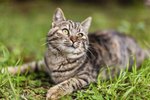
Both Bactrian and dromedary camels are adapted to survive in arid environments. While their humps don’t hold water, they are a source of energy. Camels have other, even more surprising adaptations, from their ovoid red blood cells to their ability to elevate their body temperatures.
The Humps
Camel humps are largely composed of fat rather that storing water. Because fat insulates animals, the humps keep fat localized so that the camels don’t become overheated from overabundant insulation. As the fat is metabolized when energy is needed, water is released. This reaction indirectly provides the camel with more water.
Drinking
Camels can drink a large amount at one time without becoming sick: almost 32 gallons. As they drink, water is absorbed from their stomachs and intestines slowly. Because their bodies do not release the water into the bloodstream rapidly, they are able to tolerate more dramatic shifts from hydration to dehydration. Wild Bactrian camels can even drink salty water if they don’t have access to fresh water.
Red Blood Cells
Camels have oval-shaped red blood cells, rather than the round cells common in most mammals. The red blood cells in camels are oriented in the direction of blood flow, which helps keep the cells moving through the camels’ capillary beds even during dehydration when their blood thickens. Camels also have more red blood cells circulating in their blood stream, likely because the cells are smaller, also to keep the cells flowing normally. The red blood cells also are able to expand more than the cells of other animals, 240 percent of their initial size versus the 150 percent of other animals. The cells of most other animals burst when they expand past this size.
Water Reabsorption
Camels lose less water through their urine and feces than many other mammals. Their kidneys concentrate water heavily, leading to salty urine. The intestines also reabsorb water from intestinal material as it is digested, so dry feces are produced. Animals can also lose water during respiration. Camels have evolved special nasal passageways to moisten air as they breathe it in and absorb moisture as they exhale. When they start to lose water, they first lose it from their tissues before their blood.
Body Temperature
Unlike many mammals, their temperatures fluctuate as their environmental temperatures fluctuate. Camels are able to tolerate elevated body temperatures before they need to sweat. While they don’t sweat until their temperatures reach 105.8 to 107.6 degrees Fahrenheit, they also don’t have as many sweat glands as other animals -- approximately 25 percent the amount of other ruminants. Their limbs are long, keeping their bodies away from the heated ground, which also keeps their body temperatures down. Their blood vessels are arranged so that, as their body temperatures elevate, the brain is kept at a lower temperature.
References
Photo Credits
-
Jupiterimages/Photos.com/Getty Images
Writer Bio
Elizabeth Muirhead is a practicing veterinarian with an undergraduate degree in biological sciences. She has real-world experience with the husbandry, grooming, training and feeding a variety of household pets.




